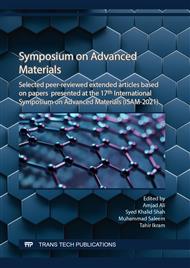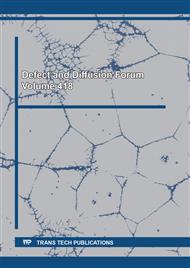[1]
C.M. Abreu, A.C. Fonseca, N.M. Rocha, J.T. Guthrie, A.C. Serra, J.F. Coelho, Poly (vinyl chloride): current status and future perspectives via reversible deactivation radical polymerization methods, Prog. in Poly. Sci. 87 (2018) 34-69.
DOI: 10.1016/j.progpolymsci.2018.06.007
Google Scholar
[2]
J. Yu, L. Sun, C. Ma, Y. Qiao, H. Yao, Thermal degradation of PVC: A review. Waste management, Waste Manage. 48 (2016) 300–314.
DOI: 10.1016/j.wasman.2015.11.041
Google Scholar
[3]
Y. Shi, Y. Wang, B. Ma, M. Ma, S. Chen, X. Wang, Tensile properties, thermal stability, and the mechanism of PVC stabilized with zinc and calcium oxolinic complexes, J. Appl. Polym. Sci. 136 (2019) 47004.
DOI: 10.1002/app.47004
Google Scholar
[4]
W. H. Starnes Jr, Structural and mechanistic aspects of the thermal degradation of poly (vinyl chloride). Progress in Polym. Sci. 27 (2002), 2133–2170.
DOI: 10.1016/s0079-6700(02)00063-1
Google Scholar
[5]
T. Dong, D. Li, Y. Li, W. Han, L. Zhang, G. Xie, J. Sunarso, S. Liu, Design and synthesis of polyol ester-based zinc metal alkoxides as a bi-functional thermal stabilizer for poly (vinyl chloride), Polym. Degrad. and Stab., 159 (2019) 125–132.
DOI: 10.1016/j.polymdegradstab.2018.11.022
Google Scholar
[6]
K. M. Goodenough, F. Wall and D. Merriman, The rare earth elements: demand, global resources, and challenges for resourcing future generations, Natural Resources Research, 27 (2017) 201–216.
DOI: 10.1007/s11053-017-9336-5
Google Scholar
[7]
R. Wen, Z. Yang, H. Chen, Y. Hu and J. Duan, Zn-Al-La hydrotalcite-like compounds as heating stabilizer in PVC resin, J. Rare Earths, 30 (2012) 895–902.
DOI: 10.1016/s1002-0721(12)60151-3
Google Scholar
[8]
B. Bartonicek, V. Hnat, B. Otahal, V. Placel, Thermal and radiation degradation of PVC Materials, (2003).
Google Scholar
[9]
Ul-Hamid, K.Y. Soufi, L.M. Al-Hadhrami, A.M. Shemsi, Failure investigation of an underground low voltage XLPE insulated cable, Anti-Corr. Meth. Mater. 62 (2015) 281-287.
DOI: 10.1108/acmm-02-2014-1352
Google Scholar
[10]
Torikai, H. Hasegawa, Accelerated photodegradation of poly(vinyl chloride), Poly.Degrad. and Stab. 63(1999) 441-445.
DOI: 10.1016/s0141-3910(98)00125-6
Google Scholar
[11]
C.V. More, Z. Alsayed, M.S. Badawi, A.A. Thabet, P.P. Pawar, Polymeric composite materials for radiation shielding: a review. Environ. Chem. Lett. (2021) 1-34.
DOI: 10.1007/s10311-021-01189-9
Google Scholar
[12]
P. Liu, M. Zhao, J. Guo, Thermal stabilities of poly (vinyl chloride)/calcium carbonate (PVC/CaCO3) composites, J. Macromol. Sci. Part B: Phy. 45 (2006) 1135-1140.
DOI: 10.1080/00222340600962650
Google Scholar
[13]
David, In Chemical Kinetics, ed. C. H. Bamford & C. F. H. Tipper, Elsevier,NY, 1975, p.1.
Google Scholar
[14]
Mita, In Aspect of Degradation and Stabilization of Polymers, ed. H. H.Jellinek, Elsevier, Amsterdam, 1978, p.24.
Google Scholar
[15]
T. Kelen, In Polymer Degradation, Van Nostrand Reinhold Co., NY, 1983, pp.77-96 and references therein.
Google Scholar
[16]
Ivan, T. Kelen, & F. Tudos, In Degradation and Stabilization of Polymers,Vol. 2, ed. H. H. Jellinek & H. Kachi, Elsevier, Amsterdam, 1989, pp.570-3, and references therein.
Google Scholar
[17]
O'Mara, M. M., J. Polym. Sci., A-I, 8 (1970) 1887 and references therein.
Google Scholar
[18]
O'Mara, M. M., Pure & Appl. Chem., 49 (1977), 649 and references therein.
Google Scholar
[19]
G. Montaudo, C. Puglisi, Evolution of aromatics in the thermal degradation of poly (vinyl chloride): a mechanistic study. Polymer Degradation and Stability. 33 (1991) 229-262.
DOI: 10.1016/0141-3910(91)90019-n
Google Scholar
[20]
Ballistreri, S. Foti, G. Montaudo, E. Scamporrino, Evolution of aromatic compounds in the thermal decomposition of vinyl polymers, J. Poly. Sci. Poly. Chem. Ed. 18 (1980) 1147-1153.
DOI: 10.1002/pol.1980.170180401
Google Scholar
[21]
Ballistreri, S. Foti, P. Maravigna, G. Montaudo, E. Scamporrino, Effect of metal oxides on the evolution of aromatic hydrocarbons in the thermal decomposition of PVC. J. Poly. Sci. Poly. Chem. Ed., 18 (1980) 3101-3110.
DOI: 10.1002/pol.1980.170181019
Google Scholar



